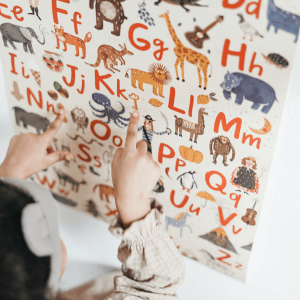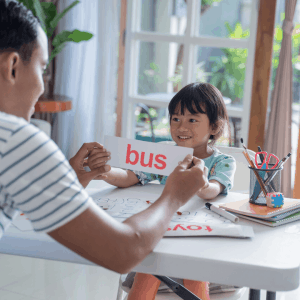We all know the value of creating an engaging, colorful, and educational space in a classroom, but did you know it is just important to make an inviting learning space at home?
Believe it or not, a dedicated home learning space can help develop your child’s creativity, sharpen their focus, and increase their motivation to read and learn. Although you do not have the same square footage as a school, with just a little bit of money and creativity you can easily create an impactful learning space!
If you need to know more about why home learning spaces matter and how you can carve out a space in your already busy home, we have some information and steps you can take to invite a spirit of learning in your home.
Why Learning Spaces Matter
So, you might be wondering why a child just can’t simply hop on the family couch and learn there. Although that can work, it might not be the best way for a child to learn. Without a specific learning spot, young learners can be easily distracted, they don’t have supplies they need nearby, and there’s no sense of consistency. The family couch, then, as comfortable and easy as it seems, may not be the right option for young children needing to learn about routines, early education, and self-regulation.
With a home learning environment, children can:
-See education as a priority in the home, meaning it sets a positive example[1]
-Learn to investigate the world, knowing that learning is everywhere, not just schools
-Have choices for reading and learning just for fun
-Set routines that support independent learning time and family planning
By making the effort to set aside a special learning space for your child, you are encouraging new skills and creating a spirit of learning that will impact your child’s life for a long time!
To help you get started, let’s look at some simple ways you can help in your child’s learning and growth.
Planning Your Home Education Space
If you are wondering how to create learning spaces when you are tight on space and money, do not worry. Below are some simple ways you can encourage and create specific spaces for home learning:
Plan For Needs, Not Pinterest
For a lot of parents there is a pressure to create Pinterest-worthy spaces for their children, but you just need to create a place for your child to explore and be creative. Believe it or not, that can be a lot simpler than you think!
So, think about how your child likes to learn and engage with the world! Ask yourself:
- Is your child an active one? Do they like sitting for long periods of time?
- Does your child like quiet spaces, or do they like sound engagement with soft music?
- What colors do they like? Are there things they find exciting, like superheroes or animals?
- Do they need a lot of options and supplies close by, or are they better with less crowded spaces?
- Do they like seclusion to focus, or are they okay with open areas?
By thinking about the learning needs of your child, you will be able to cut out a lot of unnecessary items you THINK you need; you really don’t need a lot to have a successful learning space in your home.
Have a Space Just for Learning
Most families don’t have the luxury of a whole extra room just for learning. But don’t worry. If you are stressing about where to create a space, know there are tons of exciting and easy ways you can do this!
Instead of focusing on square footage and actual space, think about creating consistency. You can dedicate a corner of a room, but you can also create learning spaces that are more flexible. For example, pull out the same foldable chairs and tables when it is time to learn, or create a learning box you can bring to the kitchen table each day. Your learning space could even be a specific lap desk in the living room.
The key is to create a specific routine and spot for your child’s learning. At the end of the day, it is most important to show your child that you value learning enough to give it a consistent place in your home.
Declutter the Space
After designating a space for learning, focus on removing distractions. Remember, less is more.
Too many toys, books, and supplies can crowd a space and create a feeling of chaos. Create an orderly environment by decluttering the area. This will greatly help your child focus on learning.
Create a Comfortable Space
Much like adults, children need to have a comfortable place to work.
As a parent, it is important to look for ways you can make learning a place where children are comfortable enough to want to extend their learning time. So, whether that is getting them bean bags to curl up in with a book or giving them a small weighted blanket to alleviate stress when learning something difficult, comfort matters!
Make Your Space Visual (But Not Too Visual)
In simplicity, the brain simply enjoys being visually stimulated.
So, when you create a learning space in your home, look for ways to create inspiring, creative, and visual places for a child’s mind to wander. For example, hang small pictures, posters, family photos, and other things that create a positive place where a child feels inspired, safe, and free. Ensure any word posters have positive reinforcement statements and shy away from hanging up rules.
Think about posters that a child will be excited to explore, like world maps, animal posters, or whatever else they might be interested in learning and seeing. Be sure to keep things simple and purposeful, and avoid hanging up too many distractions. Anything visual should add to the learning environment, not take away from it.
Organize a Well-Lit Area
Believe it or not, lighting is an important factor in effective learning spaces. In fact, Christopher Alexander, Emeritus Professor of Architecture at UC Berkeley, stated that low levels of light in classrooms affected students’ ability to regulate their natural cycle of sleep and attention. Another study found that the more natural light (or lighting that mimicked natural sunlight), the greater the students’ school attendance, achievement, and overall health.[2]
From these studies we learn that lighting can affect a child’s energy, attention, and achievement levels.
If you do not have windows or good lighting in the space where your child learns, you can also use mirrors! Place a mirror across from a window to reflect more of the natural light into the room.
Gather Books and Leave Room for Growth
Lastly, try to have books readily available and leave room for growth! Research shows that children in homes where books are readily available benefit—in terms of improved test scores—from their mere presence. And this is especially true in low-education and under-resourced homes. The research even shows that no matter how many books your home already has, every addition benefits your children even more.[3]

So whether you get them at second hand stores, check them out at the library, or buy them at bookstores, the more books you can have in your home the better! Stocking your shelves with books encourages children to explore new interests and choose reading as a pastime.
Don’t be afraid to keep some spaces empty. You do not need to fill every corner of your learning space with endless books and educational tools. The learning space should have room to change as your child’s interests, educational abilities, and passions evolve. Allow space for them to change things up and add new books or educational tools!
Make It Personal
Lastly, and probably the most impactful thing you can do when planning an educational space at home, is making it personal to your child. Be sure the space plays into their interests and encourages your child to learn!
What motivates them? What sparks their interest? What do they love learning about?
Conclusion
As a parent, you want to ensure you are doing everything you can to help your child succeed, but why not start at home? By creating a consistent space for learning, you promote lifelong learning as a priority in your family.
Believe it or not, home is just as important to a child’s education as the schoolhouse! There is a lot of learning that happens within your walls, so do not discredit the instruction that happens at home everyday. Make education part of your daily routine.
Sources:
- “Fifty Top Literacy Statistics.” Ferst Readers. https://ferstreaders.org/resources/fifty-top-literacy-statistics.
- Persaud, Ramona. “Why Learning Space Matters.” Edutopia. George Lucas Educational Foundation, September 8, 2014. https://www.edutopia.org/blog/why-learning-space-matters-ramona-persaud.
- Evans, M. D. R., Jonathan Kelley, and Joanna Sikora. “Scholarly Culture and Academic Performance in 42 Nations.” Social Forces 92, no 4. (June 2014): 1576-1605. https://doi.org/10.1093/sf/sou030.


